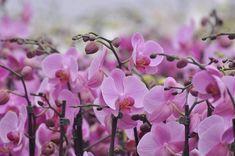
Pot plants are performing ahead of the ornamental market, with consumers short of cash but still wanting to splash out on a gift or make something of their garden instead of booking that holiday in the sun.
Once overpowered by the rose, potted orchids are now leading the market. Who would spend twice as much on a bouquet that would last two weeks at best, when a single, impressive exotic flower could say so much more, and for a longer time too?
This year saw UK nursery and pot plant supplier to the multiples Double H extend its glasshouses by 20 per cent. The extra room has all been allocated to growing orchids. “Orchid sales have seen rapid growth and continue to,” says managing director Neil Stevenson, who is based on the south coast, where light levels and temperature are consistent enough to grow orchids indoors. “Even as the rest of the market levelled out this year, orchids continue to be strong. This seems to be the trend with our more premium priced offers, where we had originally thought there would be a drop off.”
But others such as hyacinths, chrysanthemums, roses and the seasonal poinsettia are drawing attention, as well as patio vegetables -such as a tomato plant that’s sold in a pot ready to harvest -fruit trees and bedding plants.
The major retailers have around 70 per cent of the ornamental market, but mail order is growing quickly, with sales doubling last year. Garden centres remain busy outlets for people looking to make a particular purchase, rather than an impulse or gift buy.
As consumers buy into the category more, more questions are asked. One thing that has been highlighted is provenance, and the term “plant miles” has started to buzz around the industry. “More than 50 per cent of ornamental plants come from overseas, but consumers don’t realise and assume the plants are grown in the UK,” says Ian Riggs, chair of the British Protected Ornamentals Association’s (BPOA) marketing committee. “It is all about perception rather than knowledge, because people think they know.”
But with more than 6,000 ornamental growers, there is a clear message to put over, which is why the BPOA relaunched the former SEEDA and HDC-funded label Home Grown in February this year. The association hopes the accreditation will become the “Red Tractor of the ornamental industry”. It involves a self audit and a nominal one-off payment from the grower.
“Since the multiples have started to place the grower and origin on fresh produce, people have been more interested in where the plants are coming from,” says Riggs. “With terms like plant miles, we have to be careful, because how can you calculate them accurately? But with the rise of ‘eco warrior’ consumers, they want to know what they are buying is good for the environment and hasn’t travelled too far.”
Home Grown has already been taken up by a major Christmas tree grower and is tipped to become well-known in the industry, with most believing the time is now right for the label.
Chester-based nursery E Smith & Son is going to join the label. “Any label that will identify that our products are grown in Britain has got to be a good thing,” says owner Derek Smith, who supplies garden centres, charities and landscape gardeners with ornamentals from his family run business. “It’s great that it will now be policed a little. People want things to be locally sourced and it makes sense for our own costs as well. It is getting harder to make ends meet.”
Not all a bed of roses
Of course, finance is always an issue, especially with rising energy costs making the running of glasshouses lean and the added hurdle of DEFRA’s target to eliminate peat use in the amateur gardening market by 2020.
“It will be tough for those that aren’t prepared for the ban,” says Stevenson of the new peat legislation that will apply only to the UK, though not Scotland. “We are switching to a mix of soil-free media and this is something we have been working on since it was clear the recommendations were going ahead.
“The big worry is the pressure the industry is under as a whole. There is significant price pressure in energy costs that we have not been able to push along the supply chain. There have been no casualties so far, but this can’t go on forever.
“I can’t see any quick improvement in terms of the economy, so we will continue to look at our costs and grow what there is strong demand for rather than being speculative.”
Stevenson believes that there is a lack of information within the industry when it comes to consumer market trends. “Demand has been quite unpredictable and I guess it’s got something to do with people cutting back and realising that times are still hard,” he says.
But Riggs is adamant that the trend towards treating gardens as an outside room and the easy grow-your-own products are going to lead the market. “Staycations are still popular and home gardening and improvement is a big part of that,” he says.
“Where cut flowers had a steep rise and peaked, other ornamentals are a long lasting product and people have seen the benefits, whether it’s for the garden or indoors. Celebrity chefs have also helped the patio veg trend with chefs like Nigel Slater and Valentine Warner picking veg or herbs from their garden or windowsills in their programmes. The pot plant industry has worked the recession.” -



